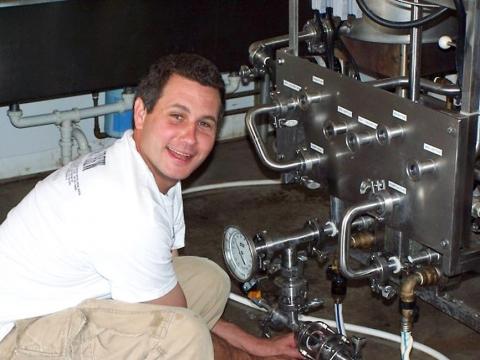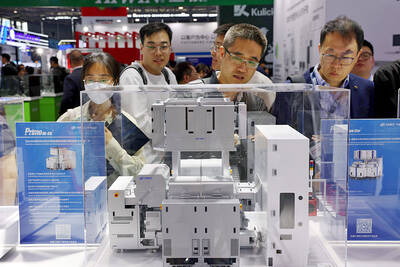Welder Mark Moynihan crawled down a narrow tube into a space the size of a car interior to seal the crack in the fermentation tank at Calhoun’s Bar-B-Q & Brewery in Knoxville, Tennessee.
The space was oversaturated with oxygen. He lit his torch, and a flash-fire erupted. His hair and clothing disintegrated instantly.
Moynihan, a contractor for the craft brewery, dragged himself up the tube and out of the vat while still on fire, suffering serious burns over much of his body. He died 75 days after the 2009 accident, just before his 40th birthday, said his widow, Kim Moynihan.

Photo: Reuters
It was not an isolated incident.
From 2009 through last year, at least four people died in craft brewery accidents in the US, compared with two deaths at large breweries that make 10 times more beer, according to a Reuters analysis of federal Occupational Safety and Health Administration (OSHA) data and local media reports.
There were also nearly four times as many safety violations at craft breweries in recent years than at large breweries. Brewery experts say the safety oversight at smaller companies is worse than official statistics might suggest because injuries, even severe ones, often go unreported.
“It was horrific,” Kim Moynihan said. “It was an accident, but it was an avoidable accident.”
She sued Copper Cellar, claiming the owner of the brewery and a small chain of Calhoun’s restaurants in the Knoxville area created a dangerous work environment, according to court documents. She settled for an undisclosed amount, but said she could not discuss the settlement further because of a nondisclosure agreement.
Nicholas Chase, a lawyer at Egerton, McAfee, Armistead & Davis representing Copper Cellar, said neither he nor his client could comment on the accident because the agreement might prohibit it. He said he was unable to immediately provide further details of the agreement.
The craft brewing industry has grown from a niche market 20 years ago into a US$10.2 billion business last year, according to the Boulder, Colorado-based Brewers Association, which represents 1,797 US craft and larger beer makers.
The association is not aware of safety issues unique to the craft brewing industry, its technical brewing projects coordinator Chris Swersey said in an e-mail.
Matt Stinchfield, a brewery safety consultant for insurance companies, said that as the industry scrambles to meet the exploding demand for craft beer, employee safety has sometimes been overlooked.
“You have a few eager entrepreneurial spirits, and they don’t come with an industrial safety background,” he said. “There is still some growing up to do.”
Brewers Association board member Gary Fish said craft brewers sometime struggled with safety, as many other small manufacturers do.
Haste causes accidents, and pressure to meet demand causes haste, said Fish, who is the founder and CEO of Deschutes Brewery in Bend, Oregon.
“It’s a challenge everywhere,” he said. “I don’t think anyone is de-emphasizing safety.”
State inspectors and OSHA found 547 violations, including 250 serious ones, at craft breweries from 2003 through 2011, according to Reuters’ analysis of the data. Officials fined the small brewers an aggregate US$220,000 for violations ranging from failing to enclose sprockets and chains to not ensuring machinery was disabled when an employee was inside.
By comparison, large brewers, such as Anheuser-Busch and Coors, had 151 violations, including 69 serious ones, during the same period.
OSHA officials declined to comment.
The Brewers Association defines a craft brewery as one that makes 6 million barrels of beer a year or less, with less than 25 percent of the company owned by an alcoholic drink maker that is not a craft brewer. Traditional recipes are also required.
To be sure, the differences in fatality and violation figures partly reflect the larger breweries’ greater automation and resources to spend on safety programs, as well as — in many cases — their more extensive experience. Safety experts say the workplace fatalities are avoidable.
Last year, for example, an employee of Redhook Brewery in Portsmouth, New Hampshire, died when a keg he was cleaning with compressed air exploded and hit him. An OSHA investigation found the air line lacked a device that would keep the pressure in the keg at safe levels. The brewery’s owner, the Craft Brew Alliance, was fined US$44,000 for that and a series of other safety violations.
Sebastian Pastore, vice president of operations for the Craft Brew Alliance, said the incident was a “freak accident” involving a plastic keg dropped off by a customer to be refilled.
The company subsequently re-examined safety issues at the brewery. It has stopped filling plastic kegs and hired an outside consultant to review safety procedures at its breweries. It now has a dedicated safety consultant for the Portsmouth brewery.
Despite the number of violations and deaths, OSHA data only show two serious injuries at craft breweries since 2002, both at the same one. Two workers were burned in separate incidents at Ballast Point Brewing Co in San Diego in July 2010 and August 2010.
Since then, the company has not had one hospitalized injury despite a fivefold increase in production and employees, chief financial officer Rick Morgan said.
Stinchfield said the number of injuries reported to OSHA does not reflect the number of injured employees. This is because brewers often do not know that many states require them to report serious injuries.
He knows of four burn cases that were never reported. Each required skin grafts and months of treatment.
In one of those cases, Teri Fahrendorf was working her first job as a rookie brewmaster at a now-closed San Francisco brewery in 1989 when she used a kettle that was too small to cook wort, a pre-beer solution.
The boiling wort spilled out of the kettle and into Fahrendorf’s knee-high rubber boots. Doctors took strips of skin from her head to graft onto her foot, Fahrendorf said.
Now she promotes safety standards in the industry as founder and president of the Pink Boots Society, a nonprofit organization dedicated to helping women succeed in brewing. Fahrendorf said the brewery did not report the incident, and it does not appear in OSHA data.
She said she had lacked promised safety and other training. Craft breweries, she said, “don’t have experience with big-boy chemicals, and they don’t have experience with pots that are filled with 900 gallons of boiling liquid.”
Bridgewater, Vermont-based Long Trail Brewing Co and its Otter Creek Brewing subsidiary are two of only three US craft brewers participating in a stringent OSHA safety program.
They joined the program, investing millions of dollars in upgrading equipment, developing safety policies and hiring a safety officer, after a 2011 fermentation tank explosion.
The blast did not injure anyone, but was a wake-up call, Long Trail Brewing Co director Jed Nelson said.
There are signs of a shift in the industry’s attitudes, said Dan Drown, an industrial chemical safety consultant who has been working with craft brewers in San Diego for the last five years.
At least 250 people attended a safety lecture at a craft brewing conference in San Diego last year, he said. More companies also are paying for safety training and classes.
“They are maturing,” he said.
The widow, Kim Moynihan, hopes that is true.
“I know it was an accident, but I believe if the employees received proper training, this would not have happened,” she said. “I think they just overlook it.”

SEMICONDUCTOR SERVICES: A company executive said that Taiwanese firms must think about how to participate in global supply chains and lift their competitiveness Taiwan Semiconductor Manufacturing Co (TSMC, 台積電) yesterday said it expects to launch its first multifunctional service center in Pingtung County in the middle of 2027, in a bid to foster a resilient high-tech facility construction ecosystem. TSMC broached the idea of creating a center two or three years ago when it started building new manufacturing capacity in the US and Japan, the company said. The center, dubbed an “ecosystem park,” would assist local manufacturing facility construction partners to upgrade their capabilities and secure more deals from other global chipmakers such as Intel Corp, Micron Technology Inc and Infineon Technologies AG, TSMC said. It

EXPORT GROWTH: The AI boom has shortened chip cycles to just one year, putting pressure on chipmakers to accelerate development and expand packaging capacity Developing a localized supply chain for advanced packaging equipment is critical for keeping pace with customers’ increasingly shrinking time-to-market cycles for new artificial intelligence (AI) chips, Taiwan Semiconductor Manufacturing Co (TSMC, 台積電) said yesterday. Spurred on by the AI revolution, customers are accelerating product upgrades to nearly every year, compared with the two to three-year development cadence in the past, TSMC vice president of advanced packaging technology and service Jun He (何軍) said at a 3D IC Global Summit organized by SEMI in Taipei. These shortened cycles put heavy pressure on chipmakers, as the entire process — from chip design to mass

Germany is to establish its first-ever national pavilion at Semicon Taiwan, which starts tomorrow in Taipei, as the country looks to raise its profile and deepen semiconductor ties with Taiwan as global chip demand accelerates. Martin Mayer, a semiconductor investment expert at Germany Trade & Invest (GTAI), Germany’s international economic promotion agency, said before leaving for Taiwan that the nation is a crucial partner in developing Germany’s semiconductor ecosystem. Germany’s debut at the international semiconductor exhibition in Taipei aims to “show presence” and signal its commitment to semiconductors, while building trust with Taiwanese companies, government and industry associations, he said. “The best outcome

Semiconductor equipment billings in Taiwan are expected to double this year, as manufacturers in the industry are keen to expand production to meet strong global demand for artificial intelligence applications, according to SEMI, which represents companies in the electronics manufacturing and design supply chain. Speaking at a news conference before the opening of Semicon Taiwan trade show tomorrow, SEMI director of industry research and statistics Clark Tseng (曾瑞榆) said semiconductor equipment billings in Taiwan are expected to grow by an annual 100 percent this year, beating an earlier estimate of 70 percent growth. He said that Taiwan received a boost from a